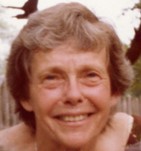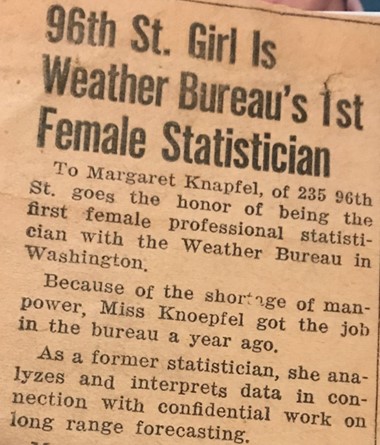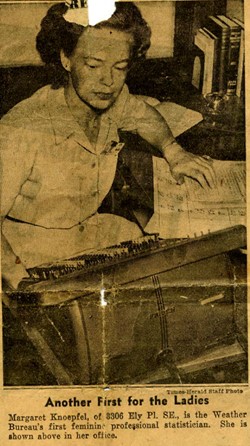
Basics: Home | About
Ways to View Yard: Area Transformations | Year | Features
Info: Plant & Animal Directories | Links
The Author at Work & Play: PS At Work | Home & Family | Travel Photo Galleries | Amusements
Margaret Smagorinsky

Margaret Smagorinsky Photo Gallery Margaret Smagorinsky Family Gallery Margaret Smagorinsky was born in Brooklyn, NY, USA on December 23, 1915, to Anne (nee Conwell) and George Knoepfel, who worked as a plumber. She was the second of four daughters, also including Alice, Gertrude, and Florence. She grew up in the Fort Hamilton area and attended Bay Ridge High School, a school for girls in Brooklyn. She was graduated from Brooklyn College with a major in mathematics and minor in education. She was the only member of her family to attend college, entering at age 15 and graduating at age 19. The Weather Bureau sent her for a year of graduate study at New York University. In later years, she took courses in mathematics and astronomy at the University of Virginia's Northern Virginia campus and chemistry at Mercer County Community College (NJ), and in anticipation of a visit to the Soviet Union, took Russian language instruction with Mouza Coutelais-du-Roche Zumwalt spouse of Admiral Elmo Zumwalt. Home and Family She met her husband, Joseph Smagorinsky, in a statistics class at NYU. They married on May 29, 1948. They lived in Princeton, NJ during her husband's appointment at the Institute for Advanced Study during the formative years of computer-based weather forecasting. The couple had five children, Anne, Peter, Teresa, Julia, and Frederick. The family lived in Alexandria, Virginia, from 1953 to 1968, during which period her husband founded the Geophysical Fluid Dynamics Laboratory under the aegis of the National Oceanic and Atmospheric Administration (NOAA). In 1968, the family moved when the lab was relocated to the Forrestal campus of Princeton University. Following the death of her husband Joseph in 2005, Margaret Smagorinsky died November 14, 2011 at the age of 95, survived by five children and eight grandchildren. She is buried in Princeton Cemetery alongside her husband. Career in Science Following college, Margaret Smagorinsky taught in Windham Central School, a one-room schoolhouse for grades 1-8 in the Ashland, NY area from 1936-1940. She then moved to Washington, D.C., where she worked for the Railroad Retirement Board as a statistician. Her next appointment was historic. Finding the bureaucratic work at the Railroad Retirement Board to be tedious and unchallenging, she was urged by a co-worker to be more aggressive in finding jobs opening up due to the U.S.'s entry into World War II. Her job search into professions historically occupied by men was helped by the war, which necessitated the drafting of males into the military, providing women with unprecedented employment opportunities. Simultaneously, the Railroad Retirement Board was preparing to move its offices to Chicago, which was prohibitively far from her family. She was able to resolve these problems with an offer to become the first woman statistician employed by the Weather Bureau (now National Weather Service). Women of her era rarely entered STEM fields. The war opened up possibilities for women like Smagorinsky to become "hidden figures" in the sciences. Although they rarely got credit or accolades, they often did critical work in advancing scientific research. At the Weather Bureau, according to a newspaper story by Tina Marranzano published in the Washington Times-Herald in the early 1940s, the work was "grubby" and "not glamorous." Smagorinsky worked in the offices of Jerome Namias and Glenn W. Brier, architect of the Brier score that measures the accuracy of probabilistic predictions. Her detailed analyses yielded "important confidential work bearing on long-range or extended forecasting activities," a new possibility available through computer technology developed in the 1940s that was pioneered by the Weather Bureau. The story continued, "Such forecasts, of utmost importance in the conduct of the war, engage the professional skills of meteorologists, climatologists, and statisticians. As a junior statistician, she assists in analyzing and interpreting data as a part of continued research into the basic problems of extending weather forecasts much beyond the limit of 20 hours," pushing the forecast range to an unprecedented five days, with an imperative to give the military an edge against its enemies. Her work in this lab yielded a scientific publication: Smagorinsky was a member of the Meteorology Project team headed by John von Neumann and Jule Charney at the Institute for Advanced Study in Princeton, NJ. in the 1940s. Their team programmed the ENIAC computer, a pioneering effort with this new technology, especially given the mammoth size of the computers and the sophistication of the tasks required of them. Her appointment was among several for project spouses, following from her husband's recruitment for the team. To test the ENIAC's accuracy as theorized by the Barotropic Equation, a task requiring computations of considerable complexity, they needed to get consistent results in comparisons between forecasts and actual weather. Prior to doing the computations with the computer, the team had a set of three statisticians analyze them by hand. As described by Steve Easterbrook, "The actual calculations for this were handled by a team of three women, led by Margaret Smagorinsky, who was, at the time, a meteorological statistician with the US Weather Bureau. The three women hand-calculated over a hundred 24-hour forecasts for this one dimensional model, using data from the Weather Bureau to initialize the forecasts. So credit for performing the first successful numerical weather forecast doesn't belong to ENIAC at all: it belongs to three 'human computers': Margaret Smagorinsky, Norma Gilbarg, and Ellen-Kristine Eliasson," each a project spouse with exceptional computational skills. Later Career Employment
With the birth of her first child in 1951, Smagorinsky left the workforce and raised her children. As they grew older, she returned to the workforce as a substitute teacher and as a Research Associate at the New Jersey Neuropsychiatric Institute in Skillman. Her work in the latter included a presentation at a scientific meeting made with Institute Director R. K. Haddad: Smagorinsky, M., & Haddad, R. K. (1970, April). "Chemical modification of structure and function of the mammalian brain." Paper presented at the Annual Meeting of the New Jersey Academy of Science. Contributions to Princeton University Smagorinsky's life in Princeton included a long association with the Princeton University League, for which she served as President among other roles. The League "was founded in April 1920 by the wives of faculty members who wanted to have an organization to promote the social interaction of faculty and help integrate new faculty families into the community. Over the years the League has grown and adapted to changing roles and in 1973 membership was opened to men." She wrote several small books featuring traditions at Princeton University that were published by the Princeton University Press, including: The Regalia of Princeton University Some Legends & Lore of Princeton University The Tigers of Princeton University These volumes remain available in the Princeton Public Library. Her volume on gargoyles followed from her role as a tour guide of the university campus. Lost Women of Science Recognition
Lost Women of Science: Bonus: The Weather Myth

Smagorinsky, M., & Brier, G. W. (1949). Verification of temperature predictions based on an alleged periodicity in solar radiation. "Bulletin of the American Meteorological Society," September, 30(7), 256-257. http://www.petersmagorinsky.net/About/BrierAndSmagorinsky.pdf
In an interview Smagorinsky related how "I feel I really wasn't a statistician. I was a statistical clerk, but they called me a statistician because that was my rating. P-1, professional. But as far as anybody else was concerned over there, I was a professional statistician. . . . I was a good technician, but I was not a theoretician. The same thing with the meteorology. I was a good technician. When I took the meteorology courses at NYU, I did very well. I did better than the [male students]. Not bragging. They didn't do so well. They weren't used to studying. . . . The main purpose of our office was, we were checking those forecasts and rating them. And every once in a while we gave a test to forecasters 'en masse'--I mean, the new ones--to see who was going to be kept." These neophytes eventually included more women following in her footsteps.

Sources:
weather/EDDEAB2832DA79CE6BB7EC8157642F71
https://www.cambridge.org/core/books/climate-demon/deducing-weather/EDDEAB2832DA79CE6BB7EC8157642F71
Podcast that includes Margaret's role in the development of computers and weather forecasting, while featuring Klara Dan von Neumann. From the introduction: The first modern-style code executed on a computer was written in the 1940s by a woman named Klara Dan von Neumann--or Klari to her family and friends. And the historic program she wrote was used to optimize nuclear weapons. This season, we dive into this fascinating moment in postwar America through Klari's work. We explore the evolution of early computers, the vital role women played in early programming, and the inescapable connection between computing and war.